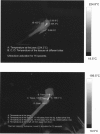How safe is high-power ultrasonic dissection?
- PMID: 12560776
- PMCID: PMC1522135
- DOI: 10.1097/01.SLA.0000048454.11276.62
How safe is high-power ultrasonic dissection?
Abstract
Objective: To evaluate the safety of ultrasonic dissection.
Summary background data: High-power ultrasonic dissection is in widespread use for both open and laparoscopic operations and is generally perceived to carry a low risk of collateral damage, but there is no published evidence for this.
Methods: Under controlled experimental conditions, ultrasonic dissections were performed in pigs using Ultracision (Ethicon) or Autosonix (Tyco/USSC) at the three power settings (3, 4, and 5) in random fashion to mobilize the cardia and fundus, bile duct, hepatic artery, portal vein, aorta from the inferior vena cava, renal vessels, colon, and ureters. The dissections (open and laparoscopic) were carried out on pigs at each power setting with each device. Thermal mapping of the tissues during dissection was performed with an infrared thermal camera and associated software. The animals were killed at the end of each experiment and specimens were harvested for quantitative histology.
Results: Extreme and equivalent temperature gradients were generated by ultrasonic dissection with both systems. Heat production was directly proportional to the power setting and the activation time. The core body temperature of the animals after completion of the laparoscopic dissections rose by an average of 2.3 degrees C. The zone around the jaws that exceeded 60 degrees C with continuous ultrasonic dissection for 10 to 15 seconds at level 5 measured 25.3 and 25.7 mm for Ultracision and Autosonix, respectively. At this power setting and an activation time of 15 seconds, the temperature 1.0 cm away from the tips of the instrument exceeded 140 degrees C. Although there was no discernible macroscopic damage, these thermal changes were accompanied by significant histologic injury that extended to the media of large vessels and caused partial- to full-thickness mural damage of the cardia, ureter, and bile duct. Collateral damage was absent or insignificant after dissections at power level 3 with both systems and an activation time not exceeding 5 seconds.
Conclusions: High-power ultrasonic dissections at level 5 and to a lesser extent level 4 result in considerable heat production that causes proximity collateral damage to adjacent tissues when the continuous activation time exceeds 10 seconds. Ultrasonic dissections near important structures should be conducted at level 3. At power levels of 4 and 5, the ultrasonic energy bursts to the tissue should not exceed 5 seconds at any one time.
Figures

References
-
- Amaral JF. Laparoscopic application of an ultrasonically activated scalpel. Gastrointest Clin North Am 1993; 3: 381–391.
-
- Humbly R, Hebda PA, Abell E, et al. Wound healing of skin incisions produced by the ultrasonically vibrating knife, scalpel, electrosurgery and carbon dioxide laser. J Dermatol Surg Oncol 1988; 14: 11. - PubMed
-
- Kinoshita T, Kanehira E, Omura K, et al. Experimental study on heat production by a 23. 5-kHz ultrasonically activated device for endoscopic surgery. Surg Endosc 1999; 13: 621–625. - PubMed
-
- Kadesky KM, Schopf B, Blair GK. Proximity injury by the ultrasonically activated scalpel during dissection. J Paediatr Surg 1997; 32: 878–879. - PubMed
-
- Haag R, Cuschieri A. Recent advances in high-frequency electrosurgery: development of automated systems. J R Coll Surg Edinb 1993; 38: 354–364. - PubMed
Publication types
MeSH terms
LinkOut - more resources
Full Text Sources
Other Literature Sources
Medical

